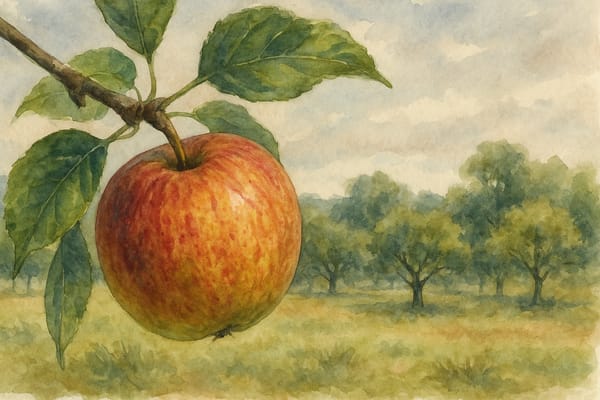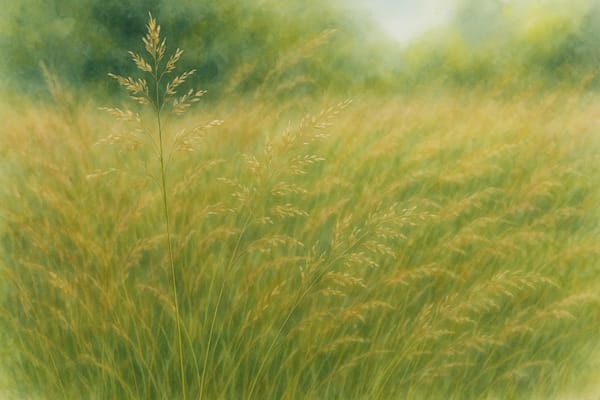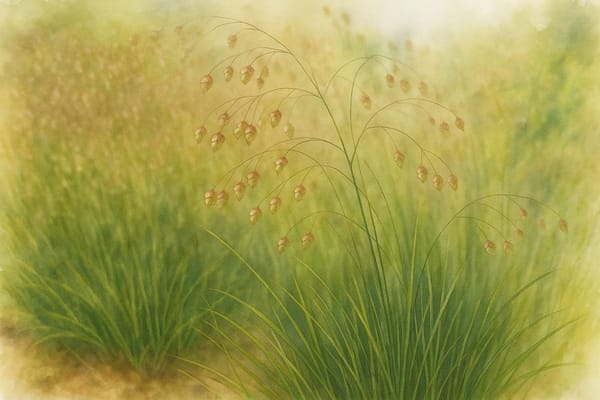In the mild, mist-washed orchards of Cornwall, where sea wind tangles with the scent of moss and salt, a rare apple ripens with a fragrance unlike any other. Spicy, floral, almost clove-like in its complexity, the Cornish Gilliflower is more than an apple. It is a living memory of land, lineage, and lost flavour — and perhaps, a key to our future orchards.
A Scent Born of Salt Air and Soil
The Cornish Gilliflower is no ordinary apple, and those who have tasted it know. When cut open, its perfume fills the room with something old-world — not sweet exactly, nor sharp, but warm, aromatic, and hauntingly floral, like a herb garden at dusk.
The name itself hints at this mystery. “Gilliflower” is an old English word, drawn from “clove” (Latin gariofilum) and once used for spicy-scented blooms like pinks and wallflowers. In the case of this apple, it’s perfectly apt: its aroma — a rare natural cocktail of esters, aldehydes, and phenolics — calls to mind not only cloves but old cider barrels, orchard woodsmoke, and honeyed spice.
And yet, despite this olfactory poetry, the Cornish Gilliflower has been all but forgotten outside its homeland.
An Orchard Treasure of Cornwall
Believed to have emerged in the late 18th or early 19th century, the Cornish Gilliflower is a regional gem — likely first discovered in the gardens of Truro or surrounding parishes. Unlike many apples bred for mass appeal, it was never part of global trade. Instead, it lived and lingered in manor orchards and village groves, handed down through generations, often by grafting onto rootstocks known only to the locals.
This tree is as Cornish as tin, granite, and salt. Adapted to the wet, sea-misted climate of the southwest, the Gilliflower ripens late in the season, often holding its fruit well into early winter — a precious trait for historical communities reliant on seasonal food storage. Its dense, crisp flesh stored well, and its fragrant complexity made it prized at table.
A Deeply Rooted Chemistry
Modern science now reveals what Cornish orchardists always knew by instinct: this apple is chemically and nutritionally exceptional.
Heritage apples like the Gilliflower are genetically wired to produce more polyphenols — a family of antioxidant-rich compounds including chlorogenic acid, catechins, and quercetin. These molecules not only fight oxidative stress in human cells but also contribute to the Gilliflower’s intense flavour and resistance to spoilage.
Studies comparing heritage apples to modern commercial types show that old varieties often contain twice the polyphenol content and up to 30% more antioxidant capacity. Their flesh isn't just tastier — it’s more nutritious. The Gilliflower likely falls at the upper end of these ranges, thanks to its high phenolic expression and flavonoid-rich peel.
Beyond the health benefits, its volatile aromatic compounds — those that give it the famed clove-like scent — are chemically distinct, forming a unique fingerprint that sets the Gilliflower apart from thousands of known cultivars.
Triploid Magic: The Genetics Behind the Scent
Peel back the bark of the Cornish Gilliflower’s family tree, and you’ll find an unusual genetic twist. This apple is a triploid, meaning it carries three sets of chromosomes instead of the usual two.
In practical terms, this means the tree is more vigorous, the fruit is often larger, and the flavour tends to be more layered and intense. But there’s a catch: triploid apples can’t pollinate other trees and require companions to bear fruit themselves. This enforced diversity shaped the structure of Cornish orchards — creating mixed plantings where mutual dependency bred biodiversity.
The triploid structure also plays into the Gilliflower’s complex traits — influencing the production of aroma and flavour compounds, disease resistance, and late-season ripening. Genes responsible for phenolic pathways, fruit texture, and sugar-acid balance are more active here, giving the apple its density, sweetness, and storability.
Genetic studies confirm that heritage apples like the Gilliflower harbour rare alleles now lost in commercial breeding. These genes don’t just make for a good apple — they represent an irreplaceable genetic library for future climate and disease resilience.
The Orchard as Archive: Cultivation and Conservation
The Cornish Gilliflower owes its survival to the old rhythms of Cornish orchard life. Before the age of supermarkets and centralised nurseries, apple trees were family heirlooms. Scions were grafted and shared among neighbours, and mixed orchards — full of trees that flowered at different times and needed each other’s pollen — were the norm.
In these community groves, the Gilliflower thrived. Its need for pollinators ensured it was always grown alongside others. This traditional practice, far from being inefficient, protected the region’s apple gene pool. It preserved not just the Gilliflower’s unique genetic code but also the diversity of its companions — a living orchard mosaic far richer than any monoculture.
As these practices faded in the 20th century, so too did many heritage varieties. But in Cornwall, a few stubborn growers and apple enthusiasts kept grafting the old wood. Their efforts mean that the Gilliflower still clings to life — a rare blossom on the endangered branch of Britain's apple heritage.
A Future Written in Genes: The Role of Genomics
Today, genomic science is unlocking the secrets that traditional orchardists could only observe. With tools like whole-genome sequencing and marker-assisted selection, researchers can now identify the exact genes that make the Cornish Gilliflower so special — from those governing aroma and antioxidant production to resilience against pests and climate stress.
This opens thrilling possibilities.
DNA barcoding can prevent misidentification and preserve true-to-type Gilliflowers. Genomic mapping can help reintroduce them into suitable microclimates or select for trees with better disease resistance or climate adaptability. And breeding programs, long dominated by yield and shelf-life, can begin to prioritise nutrition, flavour, and biodiversity — with the Gilliflower’s rare alleles offering keys to a better apple future.
In a world facing declining pollinator populations, unpredictable weather, and increasingly narrow diets, heritage apples like the Gilliflower aren’t quaint relics. They’re strategic resources — edible artefacts of resilience.
Closing the Loop: From Heritage to Hope
The Cornish Gilliflower is an apple that sings of its place. It tells the story of Cornwall’s damp, wind-polished hills and the growers who tended its orchards before flavour was traded for uniformity.
It is a rare convergence of chemistry and culture, science and scent. And now, with both modern tools and traditional wisdom at our disposal, we have the chance not only to preserve it, but to champion it — in gardens, in genomes, and on the tongue.
So plant one if you can. Graft it if you dare. Taste it, share it, tell its story. For in the clove-scented breath of the Cornish Gilliflower lies not just the memory of old orchards, but the seed of something resilient, rooted, and rare.











